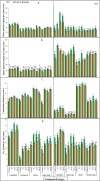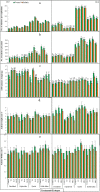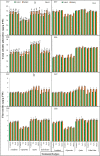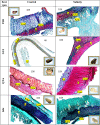Plant growth promoters mediated quality and yield attributes of milk thistle (Silybum marianum L.) ecotypes under salinity stress
- PMID: 34853350
- PMCID: PMC8636566
- DOI: 10.1038/s41598-021-02435-4
Plant growth promoters mediated quality and yield attributes of milk thistle (Silybum marianum L.) ecotypes under salinity stress
Abstract
Silybum marianum (L.) Gaertn (Astraceae) is a well-reputed medicinal plant mostly utilized for silymarin (Sily) content and oil production, however, the information about Sily contents in achene part is still fragmented under different climatic conditions. In this study four milk thistle ecotypes from Faisalabad (FSD), Gujranwala (GUJ), Quetta (QTA), and Kallar kahar (KK) having an altered achene color were analyzed under salt stress. Application of plant growth promoters (PGPs) is one of the solution for ameliorating the effect of salinity and increasing the quantity and quality traits of milk thistle, so ascorbic acid (AsA), thiourea (TU), and moringa leaf extract (MLE) were soil supplied after developing salinity stress (120 mM with irrigation) at germination stage. Predetermined levels were selected for PGPs such as AsA (500 µM), MLE (3%), and TU (250 µM). Results revealed that all yield related attributes were significantly decreased, while secondary metabolites, pericarp epidermis, pericarp parenchyma, and pericarp seed integument increased under salinity stress. Data suggested that PGPs treatment was helpful to alleviate the deleterious effects of salinity stress and enhance the milk thistle quality and quantity parameters. The ecotypic variations with altered achene color patterns represent an advantage for QTA ecotypes for higher Sily extraction under salt stressed conditions.
© 2021. The Author(s).
Conflict of interest statement
The authors declare no competing interests.
Figures






Similar articles
-
Oxidative stress tolerance potential of milk thistle ecotypes after supplementation of different plant growth-promoting agents under salinity.Plant Physiol Biochem. 2021 Sep;166:53-65. doi: 10.1016/j.plaphy.2021.05.042. Epub 2021 May 29. Plant Physiol Biochem. 2021. PMID: 34090121
-
Effect of Salinity and Plant Growth Promoters on Secondary Metabolism and Growth of Milk Thistle Ecotypes.Life (Basel). 2022 Sep 30;12(10):1530. doi: 10.3390/life12101530. Life (Basel). 2022. PMID: 36294965 Free PMC article.
-
Gene Expression Analysis and Metabolite Profiling of Silymarin Biosynthesis during Milk Thistle (Silybum marianum (L.) Gaertn.) Fruit Ripening.Int J Mol Sci. 2020 Jul 2;21(13):4730. doi: 10.3390/ijms21134730. Int J Mol Sci. 2020. PMID: 32630801 Free PMC article.
-
A review of therapeutic potentials of milk thistle (Silybum marianum L.) and its main constituent, silymarin, on cancer, and their related patents.Iran J Basic Med Sci. 2022 Oct;25(10):1166-1176. doi: 10.22038/IJBMS.2022.63200.13961. Iran J Basic Med Sci. 2022. PMID: 36311193 Free PMC article. Review.
-
Milk thistle (Silybum marianum (L.)Gaertn.): An overview about its pharmacology and medicinal uses with an emphasis on oral diseases.J Oral Biosci. 2022 Mar;64(1):71-76. doi: 10.1016/j.job.2021.12.005. Epub 2021 Dec 27. J Oral Biosci. 2022. PMID: 34968721 Review.
Cited by
-
Sodium Nitroprusside Improves the Growth and Behavior of the Stomata of Silybum marianum L. Subjected to Different Degrees of Drought.Life (Basel). 2023 Mar 24;13(4):875. doi: 10.3390/life13040875. Life (Basel). 2023. PMID: 37109404 Free PMC article.
-
Multiple Physiological and Biochemical Functions of Ascorbic Acid in Plant Growth, Development, and Abiotic Stress Response.Int J Mol Sci. 2024 Feb 2;25(3):1832. doi: 10.3390/ijms25031832. Int J Mol Sci. 2024. PMID: 38339111 Free PMC article. Review.
References
-
- Both, S., Strube, J. & Cravatto, G. Mass transfer enhancement for solid–liquid extractions. Green extraction of natural products: theory and practice. Wiley, Weinheim (2015).
-
- Abenavoli L, et al. Milk thistle (Silybum marianum): A concise overview on its chemistry, pharmacological, and nutraceutical uses in liver diseases. Phytother. Res. 2018;32:2202–2213. - PubMed
-
- Porwal O, et al. Silybum marianum (Milk Thistle): Review on Its chemistry, morphology, ethno medical uses, phytochemistry and pharmacological activities. J. Drug Deliv. Therap. 2019;9:199–206.
-
- Denev P, et al. Chemical composition and antioxidant activity of partially defatted milk thistle (Silybum marianum L.) seeds. Bulg. Chem. Commun. 2020;1:182–187.
MeSH terms
Substances
LinkOut - more resources
Full Text Sources

